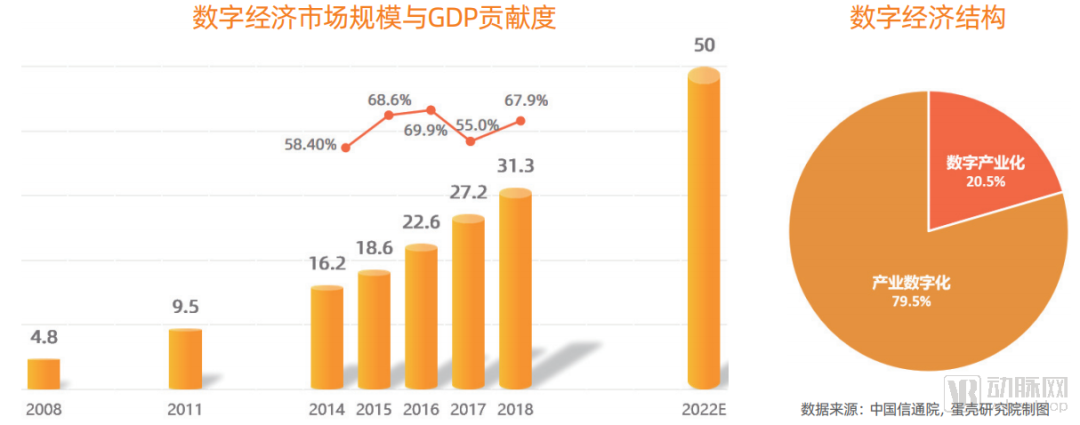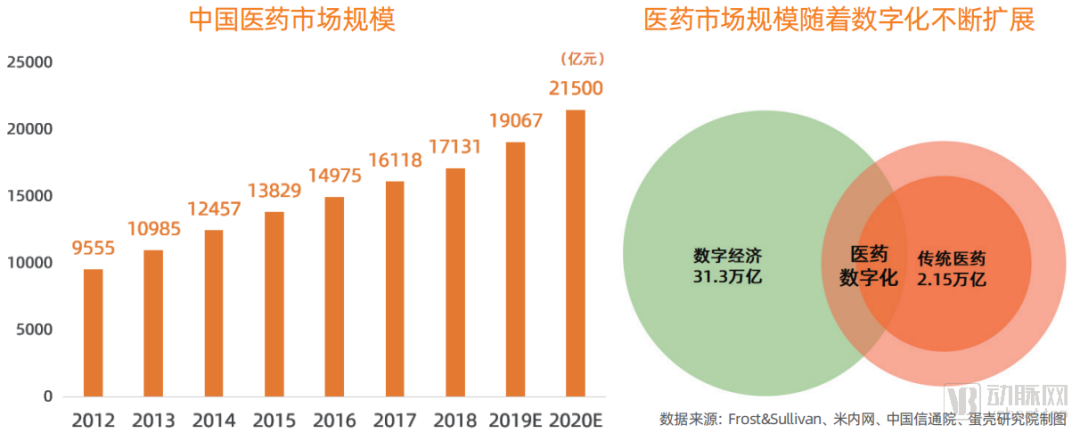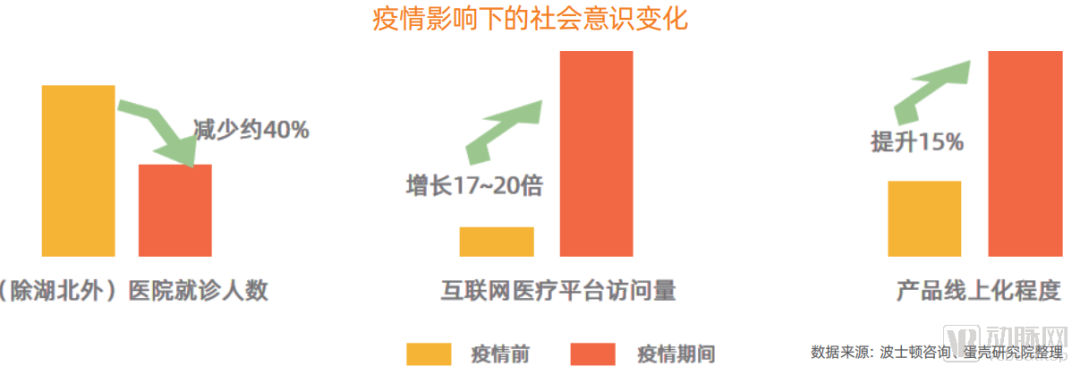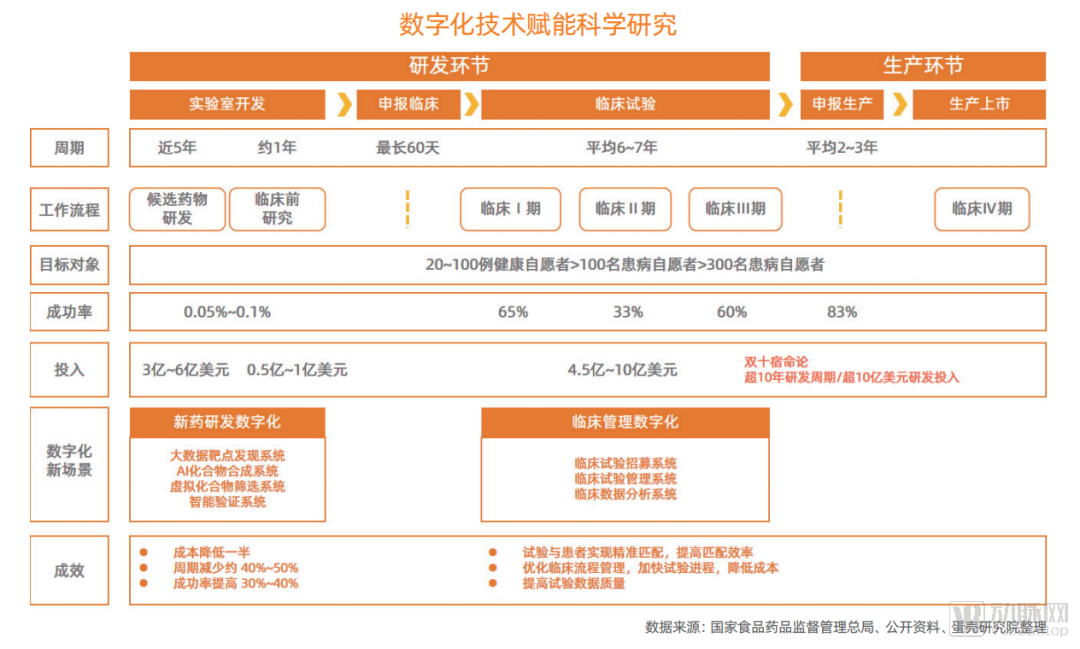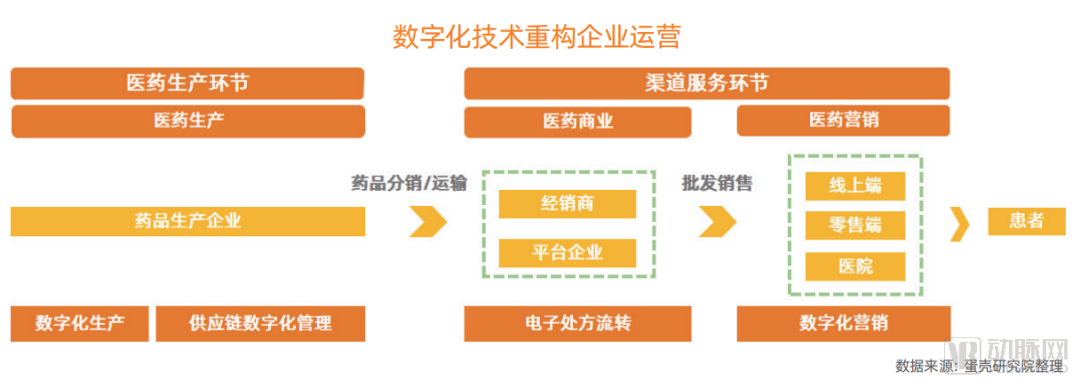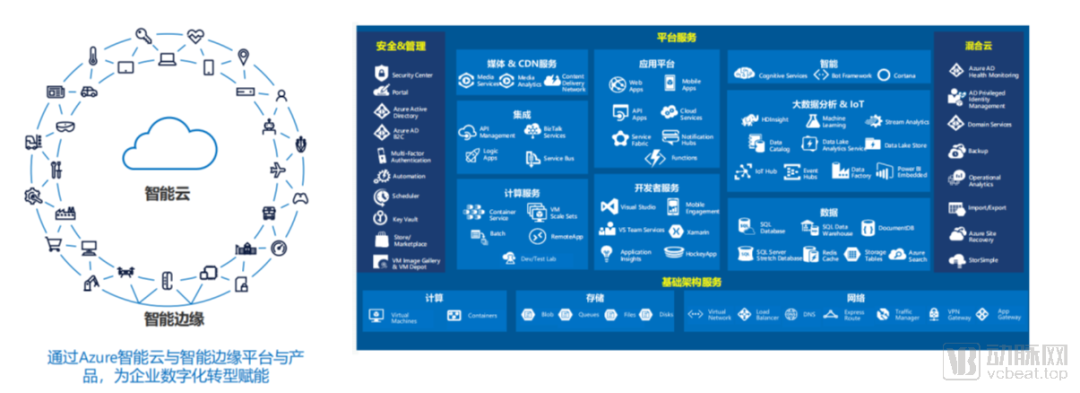/h3>
The latest research shows that in 2018, my country’s digital economy reached 31.3 trillion yuan, while China’s GDP reached 91.9 trillion yuan in the same period, accounting for 34.8% of GDP. Comparing the scale of the digital economy with a comparable caliber, the digital economy has achieved a nominal growth of 20.9%, and its proportion has increased by 1.9%. It is expected that the scale of the digital economy will reach 50 trillion yuan in 2022.
From the perspective of the structure of the digital economy, the scale of the digital sector of the industry has reached 24.9 trillion yuan, accounting for 79.5% of the digital economy, which shows that China is having a large number of enterprises in terms of business, technology, products, services, etc. Perform digital upgrades.
Picture Map: Digital Innovation Self-Portraits in Various Industries
The Eggshell Institute combed through the public information and related research reports on the current overall digital development of major industries and industry growth. After combing, we found that the pharmaceutical industry maintained a high industry growth rate and market growth rate About 10%, but the overall degree of digitization is relatively low, and the overall score is less than 15 points. Long-term high-speed growth and low digitalization at this stage are an opportunity and a challenge for the digitalization of the pharmaceutical industry.
Driven: Digital wave of medicine driven by multiple factors
Factor 1: The policy has arrived, and it will force enterprises to transform and upgrade
Since 2015, the medical reform has entered a critical stage, and various pharmaceutical industry policies have been released intensively. After collecting, collating and analyzing national-level policies that have a significant impact on the medical field through government documents, public information and other channels, we found that the policies are moving in the following directions:
R&D and production layer: Encourage the research and development of high-quality innovative drugs, give priority to the approval of high-quality innovative drugs, deepen the review and reform to solve the problem of reexamination of the drug backlog, and improve the whole process of drug supervision.
Pharmaceutical business layer: improve the reliable drug monitoring and tracing system, reduce the cost of drug circulation, and encourage the flow of drugs from the hospital to the market outside the hospital.
Medical service layer: implement medical separation, formulate and encourage “Internet + medical”, and promote graded diagnosis and treatment.
Medicine consumer layer: From the medical insurance system level, to protect the rigid demand of patients for medication, to reduce the cost of medical insurance reimbursement from the aspects of drug supply and payment, and reduce the pressure of medical insurance payment.
Under such a policy background, on the one hand, the government has increased its support for the construction of digital medical care, improved the construction of the population health information service system and promoted the application of big data in health care; on the other hand, with the establishment of the Medical Insurance Bureau With the introduction of a series of policies such as the two-vote system, generic drug consistency evaluation, and “4+7” volume purchases, fee reductions have become the theme of pharmaceutical reform, which will force pharmaceutical companies to use digital technology to improve efficiency and reduce costs .
Factor 2: The industry is reborn, finding key nodes and solving key problems
1. Panorama of key links in the entire pharmaceutical industry chain
After years of development and exploration, the Chinese pharmaceutical industry has formed a relatively complete industrial chain, which mainly includes the two major fields of pharmaceutical manufacturing and pharmaceutical circulation. The entire process includes more than a dozen key processes and many participants.
Pharmaceutical manufacturing field: refers to the formation of medicines from raw materials to final medicines. It is a process from “0” to “1”, which involves three major links: supply of pharmaceutical raw materials, pharmaceutical research and development, and final pharmaceutical production.
Pharmaceutical distribution field: refers to the process of pharmaceuticals from the pharmaceutical company to the final drug group after the mass production of pharmaceuticals, involving three major links: pharmaceutical business, pharmaceutical marketing and pharmaceutical services.
2. Key issues need to be resolved in the entire pharmaceutical industry chain
Despite the gradual improvement of the pharmaceutical industry industrial chain, the key issues that need to be resolved in each link are becoming more and more obvious, especially the implementation of a two-vote system, a series of policy measures such as medical insurance reform, will break the use of medicine to support health care. Traditional models such as medical and pharmaceutical representatives, market factors such as price and cost will force companies in all key links of the pharmaceutical industry to redeem themselves and achieve rebirth through innovation.
Factor 3: CityField space, medical digital market potential is expected
The sales of the Chinese pharmaceutical market have increased from 955.5 billion yuan in 2012 to 2.15 trillion yuan in 2020 (estimated), with an average annual compound growth rate of 10.7%. The Chinese pharmaceutical market has maintained rapid and stable growth, and the traditional pharmaceutical model It is still the main form of the industry.
But it is undeniable that with the promotion of policies and industries, the digitalization of medicine will be significantly improved. Traditional medicine will quickly move closer to digitalization. At the same time, digitalization will promote the further development of medicine. The two complement each other.
“Outbreak” offensive: the situation creates heroes
New social habits are rapidly taking shape: when hospitals cannot meet the demand for medical treatment, patients are flowing to Internet platforms and pharmacies
In the tough battle against the new coronary pneumonia epidemic, the entire medical industry is undoubtedly facing a test of great pressure. With the fermentation of the epidemic, these difficulties and changes are likely to become catalysts and accelerators for the development of the entire medical industry.
China’s traditional medical practice is to go directly to offline medical institutions, but under the epidemic, especially offline hospitals in Hubei have become a high-risk area. During the epidemic, many hospitals invested a lot of resources and medical capabilities to treat new crown patients and suspended or suspended some routine diagnosis and treatment services;
At the same time, ordinary patients also choose to go less or not to go to the hospital to avoid risks. This has pushed many patients who cannot go out or are unwilling to go to the hospital for medical treatment during the epidemic to online medical treatment. According to data from the National Health Commission, in February this year, the number of hospital visits nationwide (except Hubei) decreased by about 40%.
Digital Opportunities for Medicine: 1. The demand for digital medicine solutions has increased significantly; 2. The importance of pharmacies has increased.
New technologies are further accelerated: When clinical trial projects and supply chains are interrupted, pharmaceutical companies follow the trend to develop long-term response solutions
Since February, China has implemented strict isolation measures, which have caused some enterprises to shut down and stop production. The domestic pharmaceutical supply chain has been blocked, and pharmaceutical researchers have been shut down or fully attacked.provide better service.
The problems that cannot be solved in the traditional pharmaceutical industry chain can break through the barriers between traditional links through the empowerment, reconstruction and optimization of digital technology. Combining with the main problems we faced in the two key areas of pharmaceutical manufacturing and pharmaceutical circulation, from the perspective of value, Eggshell Research Institute combed the functions of digital products. At present, digital technology is in the medical scene. There are three main paths for applications:
Path 1: Empower scientific research. By digitally empowering multiple processes such as R&D, production, and quality supervision of new drugs, it accelerates the R&D process, improves clinical trial management, and eliminates obstacles to new product development, improves the success rate of R&D, and shortens the cycle of new drugs from R&D to mass production.
Path 2: Reconstruct business operations. Equip employees with the necessary skills and tools to streamline processes, increase productivity, and eliminate barriers to collaboration in a secure environment to achieve regulatory compliance; protect the organization’s reputation and profitability under full compliance with regulations; use safe , Operational data insight to transform operations, increase productivity, shorten time to market and increase trust.
Path 3: Optimize user experience. Communicate more directly and safely with users to increase participation, increase market efficiency, better align with users’ concerns, and reduce costs.
The above three paths can solve the long-term problems in the fields of Chinese medicine research and development, pharmaceutical production, pharmaceutical business, pharmaceutical marketing and pharmaceutical services, which are the two key areas of pharmaceutical manufacturing and pharmaceutical circulation.
Analysis of Digital Technology Innovation Products under Three Value Paths
(1) Empowering scientific research: shorten the R&D cycle and increase the success rate Overview: At present, the application of digital technology to empower scientific research is mainly based on the digitalization of new drug development and clinical management. For example, Microsoft and Swiss pharmaceutical company Novartis have signed an agreement, researchers will combine Microsoft’s advantages in the field of artificial intelligence and Novartis’ expertise in the field of life sciences to accelerate the development of new drugs. Novartis plans to apply Microsoft’s artificial intelligence tools to the entire drug development process, including research, clinical trials, production, operations and finance.
(B) Reconstruction of enterprise operations: Improve operational efficiency and reduce enterprise costs Overview: The current application of digital technology in the reconstruction of enterprise operations is based on the four digitizations of digital production, digital supply chain management, electronic prescription circulation and pharmaceutical digital marketing The product has the highest demand, and related technologies have been implemented.
For example, Microsoft and its intelligent warehousing logistics service ecological partner Geek+ (Geek Home) provide intelligent supply chain services to a well-known domestic pharmaceutical production company. Use Microsoft Azure’s data and service capabilities to build a new supply chain platform and connect internal and external systems to integrate data value and achieve end-to-end visualization from order to delivery.
(3) Optimizing the user experience: To meet the clinical needs of doctors and improve the patient’s medication experience Overview: At present, the application of digital technology to optimize the user experience is mainly based on digital doctor services and digital patient medication services.
For example, Microsoft has launched its first industry-specific cloud product, Microsoft Cloud for Healthcare, to address the issues of increased work pressure load and increased difficulty of doctors during the epidemic. Nursing staff can arrange, manage and conduct patient virtual Visit a doctor and provide corresponding services to further enhance patient communication, collaboration and management efficiency of the nursing team.
In the body of the report, we will explain in detail how to empower the eight key links of new drug development, clinical management, pharmaceutical production, supply chain management, prescription outflow, pharmaceutical marketing, doctor services and patient services through digital technology.
Path: Microsoft helps transform the medical digital industry sharing practices
As an enabling company for the digital transformation of the medical industry, Microsoft uses its own rich experience and technical platform advantages to provide the best digital transformation path for the pharmaceutical industry and help the pharmaceutical industry to smoothly transform.
Introduction to Digital Business
“Digitalization—” written by a digital expert at Microsoft (China)—The business revolution leading the era of artificial intelligence” puts forward: The core of digital transformation is to create value through transformation. Digital transformation pays more attention to the digital assets generated in each link, and uses digital assets to create new digital services and bring new business growth points.
Since 2015, Microsoft has started its own digital business transformation while innovating its own business, upgrading its core business from traditional software sales and deployment, and upgrading it to provide customers with digital solutions to help customers with digital transformation.
Four core products
There are four major digital core products that can be applied to the pharmaceutical industry: Microsoft Azure, Dynamics 365, Microsoft 365 and Power Platform. The four products promote each other to form a “big platform” and build Microsoft’s digital “four driving” carriage”.
Among them, Azure is the core service, providing the most basic technical support including cloud technology; Dynamics 365 and Microsoft 365 are upper-layer applications, mainly focused on providing productivity platforms for enterprises. The rapid development of Microsoft 365 and Dynamics 365 will promote the growth of Azure, and the growth of Azure can ensure the reliability and stability of its services.
In addition, as a scalability model, Power Platform has excellent scalability and has become a bridge tool for connecting three other types of digital products of Microsoft.
Success Stories
1. Huasu Pharmaceutical–Microsoft Dynamics helps Huasu Pharmaceutical achieve a comprehensive multi-type customer network and refined terminal sales management;
2. GSK–Customized personalized safety reporting solution helps GSK achieve safe production management
In the body of the report, we will explain in detail the framework of Microsoft’s digital transformation method and how to help pharmaceutical companies achieve digitalization.
Trend: The future of the pharmaceutical industry in the digital age
Digital innovation in the pharmaceutical industry is an innovation of the entire industry chain and multi-subject participation, involving various links such as research and development, production and pharmaceutical circulation. At the value level, the main goals of digital innovation in the pharmaceutical industry are to empower scientific research, restructure business operations and optimize users
